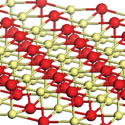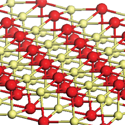Twisting left and right gives logic another turn
Germanium telluride can be thermally switched between a metastable crystalline phase and an amorphous state. In its crystalline form, it is a ferroelectric with spontaneous polarization. This structural transition would seem promising for data storage, through switching the crystalline (and hence ferroelectric) state on and off. However, applications involving germanium telluride have not been realized, primarily due to its high concentration of intrinsic vacancies.
In addition to crystal structure, size also affects ferroelectric properties. In view of this, Engin Durgun and colleagues at Université de Liège and at the Université Catholique de Louvain, both in Belgium, have performed first-principle calculations on germanium telluride nanoplatelets. For platelets with a diameter larger than 2.7 nm, they predict the emergence of polarization vortices that should give rise to a ferrotoroidic ground state, with a spontaneous and reversible toroidal moment. The authors predict that the inhomogeneous strain would play a role in stabilizing the spiral. In addition to fundamental interest, this effect, together with the transition from crystalline to amorphous structure, can be used to record three spin states (right-hand spiral, left-hand spiral, and amorphous/off), which could be used for ternary logic. – Daniel Ucko





